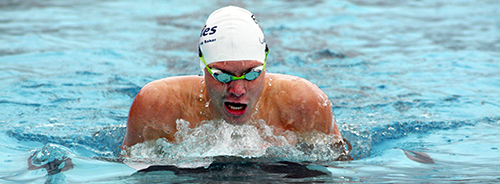
Johann van Heerden from the University of the Free State has qualified for the Paralympic Games in the swimming pool, and is now waiting to hear if he will be included in the South African team. Photo: Nadya van Heerden.
In the past couple of months, Johann van Heerden has been swimming his way to the Paralympic Games, and is still preparing as if he will be going to Rio de Janeiro.
The Kovsie swimmer, who will know whether he has been included in the Paralympic team in July 2016, feels his training is progressing well. The Olympics will be held in Brazil from 7 to 18 September 2016. If all goes well, this could be the first of several Olympics for the 20-year-old second-year Education student from the University of the Free State (UFS).
Dream year for Education student
Van Heerden (cerebral palsy), whose hero is the former Paralympic superstar Natalie du Toit, has had huge successes in the run-up to the 2016 Olympics. Among others, he was named the best senior swimmer at the Nedbank National Championships for the Physically Disabled in Bloemfontein in March 2016. At the South African Senior Championships in Durban in April 2016, he qualified for the Olympics in the 100 m breast-stroke with an A-qualifying time, and in the 50 m and 100 m freestyle with B-qualifying times.
Only three male swimmers to Olympics
However, he has to wait until the announcement of the South African Paralympic team, since only three male and three female swimmers will be selected. He will not be competing in another major event before the Olympics. “My short-term goal is to compete in this year’s Games, and, in the long term, I would like to reach even greater heights at the 2020 Games,” he said. Du Toit is an inspiration to him because “she was hard-working, and she had a lot of drive”.
Other students from CUADS also excel
At the above-mentioned National Championships, Van Heerden won a total of five gold medals (200 m medley, 100 m breaststroke, 50 m freestyle, 50 m breaststroke, and 200 m breaststroke) and one silver medal (100 m freestyle). Other students from the Center for Universal Access and Disability Support at the UFS also excelled.
Dineo Mokhosoa (cerebral palsy) won three gold medals (long jump, shot-put, and discus), while the athlete Louzanne Coetzee (blind) shattered the world record in the 5 000 m, as well as the Africa record in the 1 500 m. Juanré Jenkinson (cerebral palsy) won two silver medals (discus and shot-put) while Danie Breitenbach (blind) won two gold medals (800 m and 1500 m).